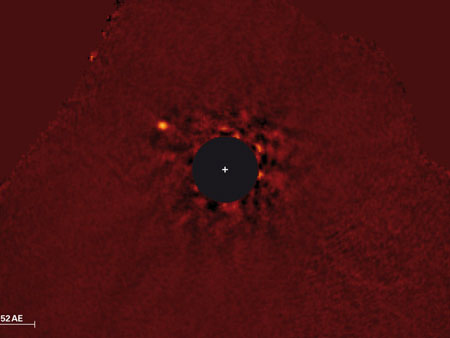| Nov 19, 2012 |
Portrait of a super-Jupiter
|
|
(Nanowerk News) Capturing an image of extrasolar planets is difficult: the celestial bodies are very far away, relatively small and drown in the light of their parent star. Despite this, a team of researchers, including several from the Max Planck Institute for Astronomy in Heidelberg, has successfully captured an image of a “super-Jupiter” which orbits the star Kappa Andromedae ("Direct Imaging Discovery of a `Super-Jupiter' Around the late B-Type Star Kappa Andromeda"). The gas giant has roughly 13 times the mass of Jupiter, while the parent star has 2.5 times the mass of the Sun. This planet probably formed in a similar way to ordinary, lower-mass planets: in a “protoplanetary disk” of gas and dust. This makes the planet an important test case for current models of how planets are born.
|
 |
| Astronomical bull's eye: False colour near-infrared image (3.8 micrometer wavelength) of the Kappa Andromedae system, taken in June 2012 with the Subaru telescope on Hawaii. Most of the light from the parent star, on which the photo is centred, was filtered out by image processing. The spots around the disk are residual effects of the starlight removed by the processing. The super-Jupiter κ And b can be clearly seen at the top left. In the image, its distance from its parent star corresponds to 1.8 times the distance between Neptune and the Sun. (© NAOJ / Subaru / J. Carson (College of Charleston) / T. Currie (University of Toronto)
|
|
Astronomical images exist for only very few of the almost 850 exoplanets which are known. To detect these planets, which orbit stars other than the Sun, researchers have to rely on indirect methods in the vast majority of cases.
|
|
A team led by Joseph Carson (College of Charleston and Max Planck Institute for Astronomy) has now photographed a large “super-Jupiter” which orbits the massive star known as Kappa Andromedae, some 170 light years away. The researchers made this discovery using the Subaru telescope on the summit of Mauna Kea in Hawaii.
|
|
Kappa Andromedae is estimated to be 30 million years old - a very young star compared to our Sun, which is around 5 billion years old. Obtaining an image of Kappa Andromedae’s companion required advanced instruments and methods for both the observation and the evaluation.
|
|
The team faced a particular challenge, as the separation between the newly discovered object and its parent star is less than twice the distance between Neptune and the Sun – most planetary images have been obtained for exoplanets which were significantly further away from their parent star, making it easier to detect them as an independent object (the average distance between the Sun and Neptune is 4.5 billion kilometres).
|
|
The object has a mass of about 13 times the mass of Jupiter and it could be either a planet or a very lightweight “brown dwarf”, an object that is an intermediate stage between a planet and a star. The data available indicate it is a planet, however.
|
|
The most interesting aspect of the discovery is that the object orbits a young, massive star. From this fact and the separation from its parent sun, the astronomers deduce that the celestial body very probably formed in a manner similar to that of smaller, lower mass planets: within a “protoplanetary” disk of gas and dust which surrounded the star during the earliest stages of its development.
|
|
In years gone by, observers and theoreticians have argued that massive stars are also more likely than our Sun to have more massive planets, for example. Yet there have also been concerns that massive stars in particular could lack the right conditions for conventional star formation. This is because such stars emit enormous amounts of high-energy radiation which could destroy and scatter a large part of a young protoplanetary disk. This would greatly obstruct the normal processes of planetary formation, and may even prevent it completely.
|
|
The discovery of the super-Jupiter Kappa Andromedae b now suggests that, at minimum, stars with masses of up to 2.5 solar masses produce large planets within protoplanetary disks – key information for researchers working on models of planetary birth.
|
|
Direct detection means the exoplanet is directly accessible to further astronomical observational techniques, such as an in-depth analysis of its light with the aid of spectroscopy. More detailed investigations of the radiation emitted by Kappa Andromedae b across a broad range of wavelengths should now provide data on the chemical composition of the gas giant’s atmosphere. In addition, the researchers want to determine its orbit data more accurately and detect possible further planets.
|
|
With this additional information it should be possible to understand the details of how the super-Jupiter formed and also to derive more general statements on planet formation at massive stars.
|

